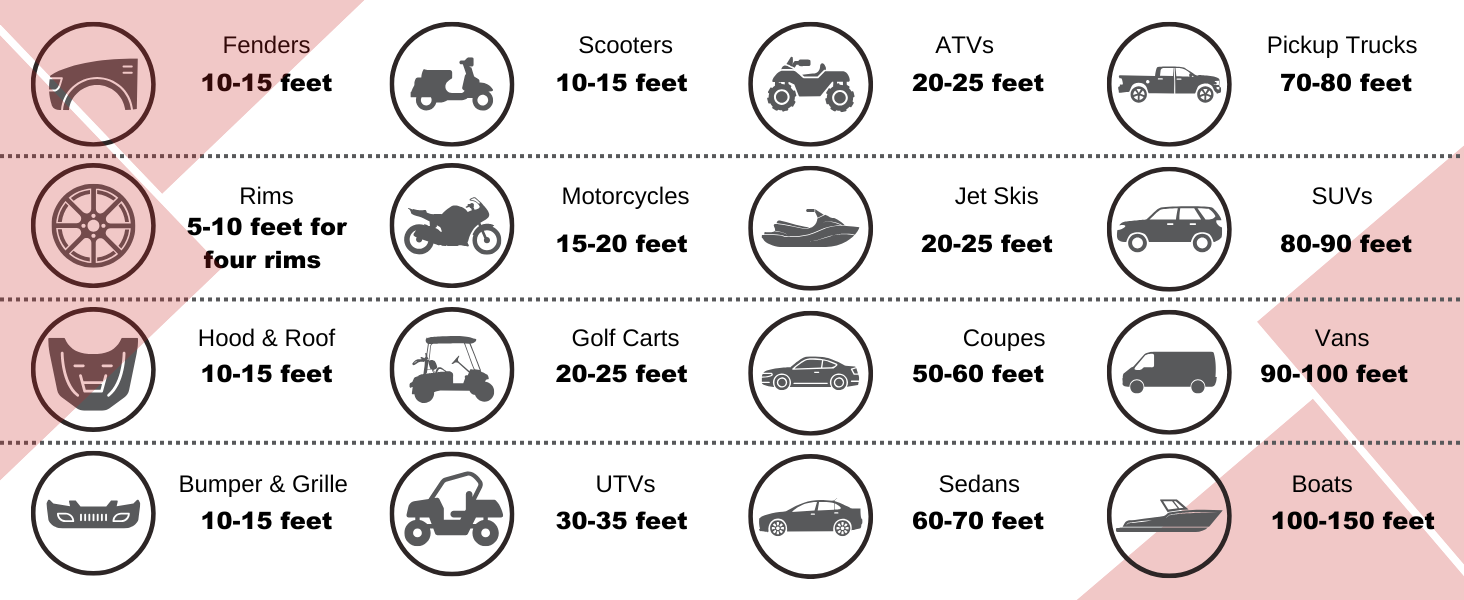
Find Out How Much Wrap You Need for Your Job
We've designed a quick and easy-to-use graphic to help our customers estimate how much vinyl wrap film they'll need for their specific projects. Whether you're wrapping smaller vehicle parts like fenders or taking on a full-size truck or boat, our visual guide breaks down the most common sizes of vinyl required by vehicle type and part. This graphic makes it easy to plan your project, ensuring you have just the right amount of 60-inch wide vinyl film, avoiding waste and ensuring smooth application.
Two Key Factors to Consider:
- Vehicle Size: Larger vehicles naturally require more wrap film to cover their body panels, doors, roofs, and other surfaces.
- Wrap Area: The surface area of specific parts like bumpers, rims, or hoods affects how much vinyl you'll need for full coverage.
With our "How Much Vinyl Do You Need?" guide, estimating the amount of wrap film becomes much simpler. The estimates listed below account for both the surface area and the curves of the vehicle or part being wrapped. Remember to always allow for a little extra material, especially when tackling curved or complex surfaces.
Here's a Quick Breakdown by Part or Vehicle Type:
- Fenders: 10-15 feet per fender
- Rims (4): 5-10 feet for all four rims
- Hood & Roof: 10-15 feet each
- Bumper & Grille: 10-15 feet total (front and rear)
- Scooters: 10-15 feet
- Motorcycles: 15-20 feet
- ATVs: 20-25 feet
- Jet Skis: 20-25 feet
- Golf Carts: 20-25 feet
- UTVs: 30-35 feet
- Coupes: 50-60 feet
- Sedans: 60-70 feet
- Pickup Trucks: 70-80 feet
- SUVs: 80-90 feet
- Vans: 90-100 feet
- Boats: 100-150 feet (depending on size and style)
Simplify Your Vinyl Wrap Project
The graphic above provides a handy reference for determining the amount of vinyl wrap you'll need for a wide range of vehicles and parts. It’s important to measure your vehicle and compare it to these general estimates, as every car or recreational vehicle may have unique curves or details that affect the wrap area.
In addition to the vehicle size, don’t forget to factor in any extra material for installation, as wrapping complex surfaces like bumpers, rims, or boat contours can demand a bit more vinyl for a seamless application. Having a small buffer ensures that you won’t run short of material midway through your project.
By planning ahead with these easy-to-follow guidelines, you can avoid common pitfalls like running out of vinyl or having too much leftover. Get ready for a hassle-free installation and enjoy the transformation that a vinyl wrap can bring to your vehicle!